
|
Sale 122
June 13-16 Pre-Long Beach Auction
| Lot |
Photo |
Description |
Realized |
Lot 1500 |
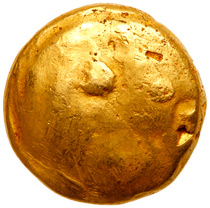 |
Celtic. Gallic War Issues, c. 60-50 BC. Gold Stater (8.21 g). Obverse Uniface. Reverse: Dis-jointed horse to right; pellet below. Spink 11; ABC 16. A touch of rose color toning adds to its appeal. Very Fine to Extremely Fine. Estimated Value $500 - UP
View details and enlarged photos
Realized
$1,076 |
|
Lot 1501 |
 |
Britain, Belgae(?). Uninscribed. Gold Stater (5.86 g), ca. 65 BC-AD 45. Chute (Durotrigan A/British B) type. Devolved head of Apollo right. Reverse: Disjointed horse left; 'crab' below; above tail, elongated pellet within elliptical ornament, row of pellets, three tiny dots in line below; pellets around. Van Arsdell 1205-7 (Durotriges); ABC 746; SCBC 22. Light deposits. Choice Very Fine. Estimated Value $400 - UP
View details and enlarged photos
Realized
$750 |
|
Lot 1502 |
 |
Britain, Belgae(?). Uninscribed. Gold Stater (6.20 g), ca. 65 BC-AD 45. Chute (Durotrigan A/British B) type. Devolved head of Apollo right. Reverse: Disjointed horse left; 'crab' below; above tail, elongated pellet within elliptical ornament, row of pellets, three tiny dots in line below; pellets around. Van Arsdell 1205-7 (Durotriges); ABC 746; SCBC 22. Very Fine. Estimated Value $300 - UP
View details and enlarged photos
Realized
$780 |
|
Lot 1503 |
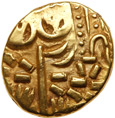 |
Britain, North-Eastern series ('Corieltauvi'). Uninscribed. Gold Stater (6.14 g), ca. 50 BC-AD 30. North East Coast (Corietauvian B) type. Devolved head of Apollo right. Reverse: Disjointed horse left; multiple pellets above, pellet below, zigzag pattern in exergue. Van Arsdell 804-1; ABC 1722; SCBC 29. Choice Very Fine. Estimated Value $500 - UP
View details and enlarged photos
Realized
$900 |
|
Lot 1504 |
 |
Lucania, Metapontion. Silver Nomos (7.73 g), ca. 400-330 BC. Head of Demeter right, wearing single-pendant earring and hair bound with sakkos; behind neck, KPI. Reverse: METAΠO[O], Grain ear with leaf to left. Noe 499 (same dies); McClean 961 (same dies); HN Italy 1537. NGC grade AU*; Strike: 5/5, Surface: 4/5. Fine style. Estimated Value $4,000 - UP
In ca. 630 BC, Metapontion was founded by Achaian Greek colonists at a site chosen for the rich soil of the surrounding territory. The city subsequently grew rich from its production and export of grain. Indeed, Metapontion and its people were so closely connected to the source of their wealth that on one occasion the Metapontines are said to have once dedicated a "golden harvest" at Delphi. This is presumed to have been a dedication of sheaves of grain made from gold. A grain ear was also well established as the civic badge of Metapontion on coins struck already in the sixth century BC.
In the fourth century BC, Metapontion began to issue a new series of nomoi that regularly featured the changeable head of a deity (here Demeter) on the obverse and a grain ear on the reverse. The reverse type follows the old tradition of featuring the civic grain-ear emblem while the obverse type of Demeter is exactly what one might expect on a coinage struck by a city devoted to growing rich from agriculture. Without the assistance of Demeter, the Greek agricultural goddess par excellence, the Metapontines might suffer drought, crop failure, and the end to their grain-derived wealth. In order to ensured that the city remained on Demeter's good side, Metapontion contained several sanctuaries dedicated to the goddess. The most notable of these had been the house of the sixth-century political philosopher Pythagoras. He had lived in Metapontion after fleeing from Kroton. After he died, the house was consecrated to Demeter.
*This coin contains the COIN WORLD PLUS sticker.
Private purchase from Freeman & Sear 8-10-2007.
View details and enlarged photos
Realized
$4,800 |
|
Lot 1505 |
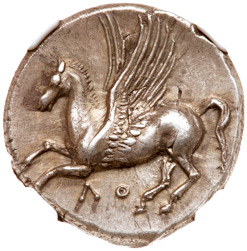 |
Bruttium, Lokris. Silver Stater (8.58 g), ca. 350-275 BC. ΛO, Pegasos flying left. Reverse: Helmeted head of Athena right; no controls. Pegasi 5. HN Italy 2338. SNG ANS 506. NGC grade Ch AU; Strike: 4/5, Surface: 3/5. Brushed. (we see no evidence of being "brushed"). Estimated Value $1,500 - UP
The perfect centering and beautifully sharp strike make this coin a wonderful example of the Corinthian type staters struck at Lokris in the late fourth and early third centuries BC. Although Lokris had struck nomoi with its own civic types earlier in the fourth century BC, staters on the Corinthian model were subsequently produced primarily to pay mercenary troops hailing from the Peloponnesos. Corinthian staters were well-known to Peloponnesians and could be easily spent back home, whereas the usual Achaian-weight nomoi might not pass as easily for mercenaries once they got back to the Peloponnesos.
This particular issue might have been struck for the mercenary forces of Dionysios II, the exiled tyrant of Syracuse. In 352 BC, he is known to have seized Lokris and installed a garrison in the city. This was only expelled by a Lokrian uprising that took place in 346 BC, while Dionysios II was away from the city. Alternatively, it may have been produced in support of the primarily Peloponnesian mercenary forces brought by Archidamos III of Sparta (in 342-338 BC), Alexander the Molossian (in 333-331 BC), Kleonymos of Sparta (in 303-302 BC), and Pyrrhos of Epeiros (in 280-275 BC) to defend Tarentum and the other Greek cities of southern Italy against the neighboring Lucanians and other Italic peoples. Indeed, Lokris served as an important base for Pyrrhos, but suffered abuses from his garrison. After an abortive revolt, Pyrrhos forced the city to pay a large indemnity and suffer the plunder of its temple of Persephone.
*This coin contains the COIN WORLD PLUS sticker.
Privately purchased from Lucien Birkler, 20 November 1993.
View details and enlarged photos
Realized
$2,760 |
|
Lot 1506 |
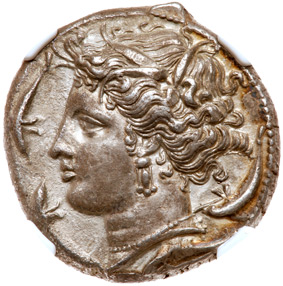 |
Sicily, Entella. Silver Tetradrachm (17.39 g), ca. 320/15-300 BC. Siculo-Punic issue. Wreathed head of Arethusa left, wearing triple-pendant earring and necklace; four dolphins around. Reverse: S'MMHNT, Horse's head left; behind, palm tree. Jenkins 152 (O47/R137); SNG Lloyd 1631 (same obv. die). NGC grade AU; Strike: 5/5, Surface: 4/5. Fine style. Estimated Value $5,000 - UP
The typology of this coin illustrates the great influence that the coinage of Syracuse still maintained at the end of the fourth century BC. The obverse type is a fairly faithful copy of the head of Arethusa surrounded by dolphins found on contemporary Syracusan tetradrachms, although she may have been understood by the Punic issuers as a representation of Tanit, the patron goddess of Carthage. The horse's head and palm tree on the reverse serve to advertise the origins of the issuers. The former was a civic badge of Carthage, which was said to have been founded on a hill where a horse's head was found buried in the ground while the palm tree (phoenix in Greek) is a punning reference to the Phoenician - and perhaps specifically Tyrian - origin of Carthage. The Punic inscription refers to the issuing authority as "the people of the camp," clearly indicating that the coin was struck to finance the frequent Punic campaigns against Syracuse and the other Greek cities of eastern Sicily. This particular issue was probably struck in connection with the great war of 311-306 BC that saw Punic forces under Hamilcar overrun most of Sicily to the gates of Syracuse, but he was forced to withdraw after Agathokles, the tyrant of Syracuse, led an unexpected invasion of Carthaginian territory in North Africa.
*This coin contains the COIN WORLD PLUS sticker.
Ex Goldberg 69 (30 May 2012), 3040; Ex Gorny & Mosch, 2005.
View details and enlarged photos
Realized
$9,900 |
|
Lot 1507 |
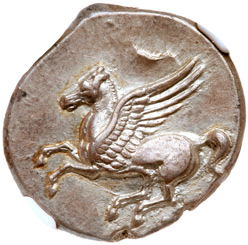 |
Sicily, Syracuse. Timoleon and the Third Democracy. Silver Stater (8.20 g), 344-317 BC. 344-339/8 BC. Pegasos flying left. Reverse: ΣYPAKOΣIΩN, Helmeted head of Athena right; behind neck, AI. Pegasi 7; HGC 2, 1400. NGC grade AU; Strike: 5/5, Surface: 3/5. Fine style, brushed. Estimated Value $1,000 - UP
After decades of suffering under the tyrants Dionysios I, his son Dionysios II, and Hiketas of Leontinoi, in 344 BC the Syracusans had finally had enough and begged for aid from Corinth, the mother-city of Syracuse. Corinth responded by dispatching Timoleon at the head of a Peloponnesian mercenary army in order to overthrow the tyrants and establish a new democratic constitution. By 343 BC, Timoleon had expelled both Hiketas and Dionysios II and began the work of destroying the symbols of the former tyrannies and restoring constitutional government at Syracuse. However, while Dionysios II had surrendered and quietly went into opulent retirement at Corinth, Hiketas remained at large and called in support from Carthage. Although Hiketas received a great Punic army to sweep him back to power, this was defeated by Timoleon and his much smaller force while attempting to cross the Krimissos River in 339 BC. Having expelled the tyrants, restored good government, and freed Greek Sicily from the Punic menace, Timoleon promptly retired to private life.Although Syracuse is most famous for its highly-artistic Attic-weight tetradrachms of the late fifth and fourth centuries BC, this Corinthian-type stater was struck by the city to meet the requirements of Timoleon�s mercenaries. As they hailed primarily from the Peloponnesos, the types and weight of the Corinthian stater would have been well known to them as a coin that could be easily spent at home, and thus was copied by Syracuse.
Purchased privately from Leu Numismatik, 20 August 2004.
View details and enlarged photos
Realized
$2,880 |
|
Lot 1508 |
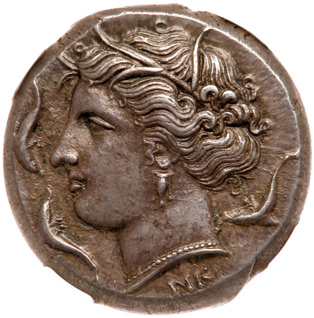 |
Sicily, Syracuse. Agathokles. Silver Tetradrachm (17.20 g), 317-289 BC. Ca. 317-310 BC. Wreathed head of Arethusa left, surrounded by three dolphins; below neck, NK. Reverse: [Σ]YPAKOΣIΩN in exergue, charioteer, holding goad and reins, driving galloping quadriga left; above, triskeles; in exergue, monogram. Ierardi 42b (O8/R23; this coin); SNG Manchester 495 (same obv. die); SNG ANS 639 (same rev. die). Beautiful old cabinet toning. NGC grade Ch AU*; Strike: 5/5, Surface: 5/5. Fine style. Estimated Value $5,000 - UP
Although this tetradrachm names the Syracusans as the issuing authority, it was actually struck during the rule of Agathokles as tyrant of the city. It was probably struck to finance the increasingly desperate war against the Carthaginians in Sicily that forced Agathokles to flee Syracuse in 310 BC and attempt to inflict losses on Carthage at home. Although he managed to capture several cities on the coast of what is now modern Tunisia, his forces were soundly defeated in 307 BC. At this point, Agathokles abandoned his army (and his two sons!) and secretly sailed back to Sicily. Despite this ignominious end to the war in North Africa, Agathokles had proved himself dangerous enough that the Carthaginians abandoned the siege of Syracuse and accepted a peace settlement.The types of Arethusa and a racing quadriga had been traditional at Syracuse since the fifth century BC, but the issue of Agathokles is notable for its prominent use of an additional triskeles symbol. The triskeles was often used in antiquity as a symbol of the three-cornered island of Sicily and here may advertise his ambition to become the king of all Sicily - a title he finally claimed for himself in 305 BC.
Ex Capt. E.G. Spencer Churchill Collection (Ars Classica XIV, 2 July 1929), 139; Ars Classica XII (18 October 1926), 987
.
View details and enlarged photos
Realized
$19,800 |
|
Lot 1509 |
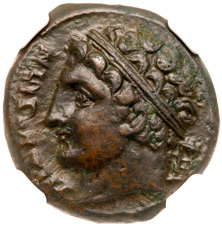 |
Sicily, Syracuse. Agathokles. Æ Litra (6.80 g), 317-289 BC. Ca. 308/7 BC. ΣYPAKOΣIΩN, diademed youthful head of Herakles right; behind, tripod. Reverse: The Nemean lion standing right, raising foreleg; club above, race torch in exergue. BAR Issue 24; CNS 151 Ds 110 Rs 50; Virzi 1662 (this coin); HGC 2, 1465 (Fourth Democracy). NGC grade ChXF; Strike: 5/5, Surface: 4/5. Flan flaw While the NGC insert mentions a flan flaw, we don't see one on this coin. We do note a small die-break on the reverse above the lion. Estimated Value $400 - UP
Although this coin has often been attributed to the Syracusan tyranny of Agathokles, the legend naming the Syracusans strongly suggests that it was actually produced under the fleeting fourth Syracusan democracy. After ruling as tyrant (317-289 BC) and self-proclaimed king of Sicily (304-289 BC), Agathokles restored a democratic constitution to Syracuse on his deathbed out of fear that he would be succeeded by his grandson Archagathos the younger. The latter was widely suspected of having poisoned his grandfather in order to seize power and avenge his own father, whom Agathokles had abandoned to his fate in North Africa in the aftermath of his abortive campaign against Carthage. The types depicting Herakles and the Nemean lion advertise the Doric Greek ancestry of the Syracusans (the Dorians claimed descent from the Heraklidai�the children of Herakles). The representation of the hero as a youth wearing a tainia, rather than the lion skin that was so popular on contemporary silver coinage, may perhaps have served as a crypto-portrait of Agathokles wearing the diadem of kingship.
Purchased privately from Edward J. Waddell, 30 September 2001. Ex Virzi Collection.
View details and enlarged photos
Realized
$576 |
|
Lot 1510 |
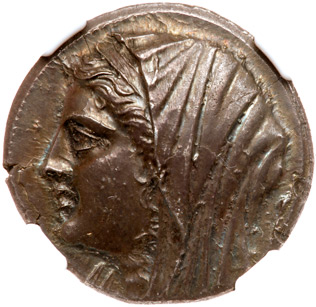 |
Sicily, Syracuse. Philistis, wife of Hieron II. Silver 16 Litrai (13.57 g), 275-215 BC. Under Hieron II, ca. 218/7-215 BC. Diademed and veiled head of Philistis left. Reverse: BAΣIΛIΣΣAΣ ΦIΛIΣTIΔOΣ, Nike driving galloping quadriga right, holding reins; above, crescent; below horses' forelegs, grain ear. CCO 75 (D 11/R46; this coin); HGC 1556; SNG ANS 882. Incredible old cabinet toning! NGC grade Ch AU; Strike: 4/5, Surface: 4/5. Flan flaws (very minor and hardly worth mentioning(. Estimated Value $4,000 - UP
Philistis, the wife of Hieron II of Syracuse, is known by name only from the coins struck in her name and from a Greek inscription on the theater of Syracuse. While the quadriga type on the reverse had been traditional for Syracusan silver since the fifth century BC, the obverse portrait of the queen is very contemporary and Hellenistic in style. The representation of Philistis veiled and wearing the diadem (the Hellenistic symbol of royal status par excellence) is very much inspired by depictions of Arsinoe II on Ptolemaic gold coins. This is perhaps not overly surprising since Syracuse and Ptolemaic Egypt together dominated the western Mediterranean grain export trade and Hieron II is known to have been on very friendly terms with Ptolemy III. However, whereas Arsinoe II is clearly deified on Ptolemaic coins, Philistis here is merely idealized. She is clearly a queen, but not a goddess. This humble quality is perhaps to be expected for the depiction of a queen whose husband rose first from the status of a military commander to that of tyrant, and then to king.
Ex CNG/NAC 40 (4 December 1996), 918; J. Pierpont Morgan Collection (Wayte Raymond FPL, 1953), 156. Included is the original 1953 Wayte Raymond Sale catalog.
View details and enlarged photos
Realized
$6,300 |
|
Lot 1511 |
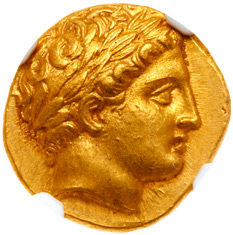 |
Macedonian Kingdom. Philip II. Gold Stater (8.61 g), 359-336 BC. Pella, ca. 323/2-315 BC. Laureate head of Apollo right. Reverse: ΦIΛIΠΠOY, Charioteer, holding kentron and reins, driving galloping biga right; below, bee. Le Rider 531-46 (unlisted dies); SNG ANS 180. NGC grade MS; Strike: 5/5, Surface: 3/5. Fine style, brushed. Estimated Value $4,000 - UP
While it is very clear that the reverse type of Philip II's tetradrachms specifically refer to the victory of his horse in the Olympic games of 356 BC, it is uncertain whether the reverse type of his gold staters should also refer to an Olympic victory. While he is known to have entered drivers and won the tetrippon (four-horse chariot race) in both 352 and 348 BC it is unclear whether he entered, let alone won the synoris (two-horse chariot race). It may be that the chariot type is simply another visual pun on his name, which in Greek literally means "lover of horses." Philip's staters were very popular and were known in common parlance as philippeioi ("Philips") and circulated widely beyond the borders of Macedonia. Indeed, they enjoyed such great popularity, that they continued to be struck long after his death and even after that of his son, Alexander the Great. They were so well-regarded by the Celts that they provided the typological model for most Celtic gold coins down to the Roman conquest of Gaul in the 50s BC.
*This coin contains the COIN WORLD PLUS sticker.
Purchased from Jonathan K. Kern 6-15-1993.
View details and enlarged photos
Realized
$9,000 |
|
Lot 1512 |
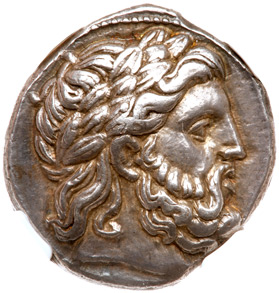 |
Macedonian Kingdom. Philip II. Silver Tetradrachm (14.47 g), 359-336 BC. Amphipolis, ca. 342/1-329/8 BC. Laureate head of Zeus right. Reverse: ΦIΛIΠ-[Π]OY, youth on horseback right, crowning horse with palm; below horse's belly, bee; below horse�s raised foreleg, stern. Le Rider 489 (D238/R437); SNG ANS 560-5. Attractive light cabinet tone. NGC grade Ch XF; Strike: 5/5, Surface: 4/5. Estimated Value $2,000 - UP
The reverse type of this tetradrachm is of great historical importance because it represents a notable incident that is recorded in the life of Philip II. In 356 BC, a horse that the Macedonian king had entered in the 106th Olympic games was victorious. This coin depicts this winning horse along with its diminutive jockey holding the palm branch of victory. The type is also notable as a punning symbol to represent the king�s name. Philip literally means "lover of horses" in Greek.The tetradrachms of Philip II circulated in Macedonia as well as beyond the borders of the kingdom, particularly to the north, where they were popular with a variety of Thracian, Dacian and Celtic peoples. They inspired numerous Celtic and other imitative issues and were often the preferred coinage of mercenaries outside of the Macedonian kingdom. Due to their wide circulation and special popularity in some regions, the tetradrachms of Philip II continued in production long after Philip, and even his son Alexander the Great, were dead.
Purchased from Edward J. Waddell 8-15-1996.
View details and enlarged photos
Realized
$2,400 |
|
Lot 1513 |
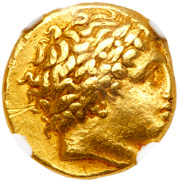 |
Macedonian Kingdom. Philip II. Gold Stater (8.60 g), 359-336 BC. Minted at Pella, ca. 323/2-315 BC. Laureate head of Apollo right. Reverse: ΦIΛIΠΠOY, Charioteer, holding kentron and reins, driving galloping biga right; below, Boeotian helmet right. Le Rider 551 (D230/R398). NGC grade XF; Strike: 3/5, Surface: 2/5, scratches . Estimated Value $2,000 - UP
View details and enlarged photos
Realized
$2,640 |
|
Lot 1514 |
 |
Macedonian Kingdom. Alexander III 'the Great'. Gold Stater (8.56 g), 336-323 BC. Salamis, under Nikokreon, ca. 323-315 BC. Helmeted head of Athena right. Reverse: AΛEΞANΔPOY, Nike standing left, holding wreath and stylis; rudder in left field. Zapiti & Michaelidou -; Price 3149; Newell 11. NGC grade Ch AU; Strike: 5/5, Surface: 4/5. Estimated Value $3,000 - UP
This posthumous stater features the imperial types that Alexander the Great established for his gold coinage at the outset of his reign. It is generally thought that they alluded to his characterization of his grand campaign against the Persian Empire as a Greek war of revenge for Xerxes' failed invasion of mainland Greece in 480-479 BC. The head of Athena refers to the Persian destruction of Athens while Nike holding a stylis (i.e., a ship's mast) recalls the naval victories at Salamis and Mykale that ultimately forced the withdrawal of the Persians from Greece. Ironically, by the time this coin was struck, Alexander was not only dead, but had long before abandoned the revenge motive for the conquest. Indeed, at the end of his life he was actively trying (and failing) to unite Macedonian and Persian in his army and his wider empire. In this project he was way ahead of his time and deep resentment in the army has informed the ancient rumors that Alexander did not die of illness, but was actually poisoned.
This particular issue is usually attributed to Nikokreon of Salamis, a Cypriot city-king who wisely paid homage to Alexander while he was besieging Tyre in 331 BC. In return, Alexander permitted him to retain his kingdom. After the death of Alexander, in 315 BC, Nikokreon supported Ptolemy in overthrowing other city-kings of Cyprus who were allied with his dangerous rival, Antigonos Monophthalmos. He was subsequently rewarded by being made king not only of Salamis, but also of Kition, Lapithos, Keryneia, and Marion. The stater may have been struck in the context of the conflict that raised Nikokreon to be ruler of all Cyprus.
*This coin contains the COIN WORLD PLUS sticker.
Purchased privately from Edward J. Waddell, 28 August 2000.
View details and enlarged photos
Realized
$15,000 |
|
Lot 1515 |
 |
Macedonian Kingdom. Alexander III 'the Great'. Silver Tetradrachm (17.15 g), 336-323 BC. Babylon, probably struck under Antigonos I Monophthalmos, ca. 315-312 BC. Head of Herakles right, wearing lion's skin headdress. Reverse: BAΣIΛEΩΣ AΛEΞANΔPOY, Zeus seated left, holding eagle and scepter; in left field, monogram within wreath; below throne, H. SC 82.6 (Seleukos I); Price 3704; HGC 9, 10f (Seleukos I). Lovely delicate golden toning adds to this coin's beauty. NGC grade Ch AU*; Strike: 5/5, Surface: 4/5. Fine style. Estimated Value $1,500 - UP
The present Alexandrine tetradrachm was attributed to the early reign of Seleukos I at Babylon following his return from exile in 312 BC and assigned to a so-called "imperial workshop" by Houghton and Lorber. However, subsequent reassessments of the relationship of this coinage to other issues certainly struck under Seleukos I; the fact that it never names him, but only Alexander; and its primary appearance in western hoards have led to the conclusion that it was probably not struck by Seleukos I after all, but rather by the Antigonid garrison installed in Babylon to hold the city against him in the period 315-312 BC. When the garrison was driven out, the coins moved west with the mercenaries who had been paid with them, and Seleukos was left to begin construction of a great empire that would stretch from the Mediterranean to the borders of India by the time of his death in 281 BC. As such, the tetradrachms (and smaller fractions) of the "imperial workshop" mark a critical turning point in the history of the ancient Near East.
Privately purchased from Stack's, August 4, 1993.
View details and enlarged photos
Realized
$3,360 |
|
Lot 1516 |
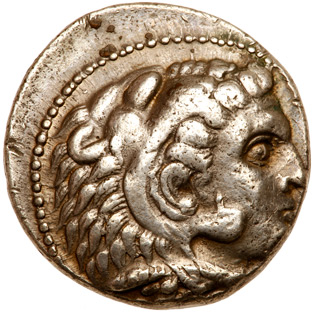 |
Macedonian Kingdom. Alexander III 'the Great'. AR Tetradrachm (16.99 g), 336-323 BC. Tyre, RY 38 of 'Ozmilk' Ake (311/0 BC). Head of Herakles right, wearing lion's skin headdress. Reverse: AΛEΞANΔPO[Y], Zeus seated left, holding eagle and scepter; in left field below arm, date. Price 3298 (Ake); Newell 47. Lightly toned. Choice Very Fine. Estimated Value $500 - UP
View details and enlarged photos
Realized
$504 |
|
Lot 1517 |
 |
Macedonian Kingdom. Antigonos II Gonatas. Silver Tetradrachm (16.98 g), 277/6-239 BC. Amphipolis, ca. 274/1-260/55 BC. Horned head of Pan left, lagobolon over shoulder, on central boss of Macedonian shield, the border decorated with eight-pointed stars within double crescents. Reverse: BAΣIΛEΩΣ ANTIΓONOY, Athena Alkidemos advancing left, holding forth shield decorated with aegis and preparing to cast thunderbolt; in inner left field, crested Macedonian helmet; in inner right field, KT. Touratsoglou 41-2; SNG Saroglos 926-7. Very Fine. Estimated Value $250 - UP
From the KSG David Zeng of Peking Collection.
View details and enlarged photos
Realized
$630 |
|
Lot 1518 |
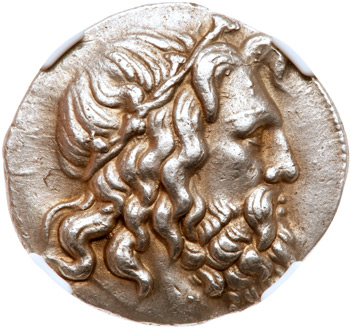 |
Macedonian Kingdom. Antigonos III Doson. Silver Tetradrachm (17.07 g), 229-221 BC. Amphipolis, ca. 227-225 BC. Head of Poseidon right, wreathed with marine plants. Reverse: BAΣIΛEΩΣ ANTIΓONOY inscribed on side of prow, Apollo seated left on prow, testing arrow; below, monogram. Touratsoglou 52-3; SNG Alpha Bank 1046-7; SNG Saroglos 933. NGC grade Ch XF; Strike: 5/5, Surface: 4/5. Fine style. Estimated Value $2,500 - UP
There remains some controversy in modern scholarship over whether the types of the present tetradrachm were struck by Antigonos III Doson or his predecessor, Antigonos II Gonatas. While there can be little doubt that the types advertise Antigonid Macedonian naval power, early numismatists believed that they reflected the victory of Antigonos II over the Ptolemaic fleet at the battle of Kos (c. 285 BC). In this case, the reverse depiction of Apollo on the prow was thought to allude to the celebratory dedication of the king�s ship to Apollo at Delos that followed the victory. In the 1990s, however, new hoard evidence seemed to argue in favor of attribution to Antigonos III Doson in association with his naval expedition against Caria in 227 BC. Nevertheless, reconsideration of the hoard chronology in the early 21st century and monograms shared between the Poseidon/Apollo on prow series and other tetradrachms attributed to Antigonos II again raises the possibility that the former are actually issues of that king rather than of Antigonos III.Antigonos III was not actually in the regular line of Antigonid royal succession, but became regent for his young nephew, Philip V. His successes in reconquering rebellious cities in Thessaly and repelling the Dardanians in 229-228 BC supposedly led the Macedonian nobles to grant him the royal title. Following the Carian expedition, Antigonos III reasserted Macedonian authority in mainland Greece by reconstituting the old Hellenic League of Alexander the Great and crushing the Spartans at the battle of Sellasia (222 BC). From this victory he was forced to immediately march north to deal with an Illyrian invasion of Macedonia. During the fighting he fell, not from wounds, but from a sudden aneurism brought on by shouting orders to his troops. Antigonos III died, leaving Philip V with a much stronger kingdom than he might have had without him.
Ex Stack's (June 1994), 2104.
View details and enlarged photos
Realized
$8,100 |
|
Lot 1519 |
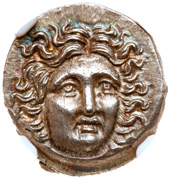 |
Macedonian Kingdom. Time of Perseus. Drachm (2.75 g), 179-168 BC. Third Macedonian War issue. Uncertain Thessalian mint, ca. 171/0 BC. Hermias, magistrate. Head of Helios facing slightly right. Reverse: Rose with bud to right; above, magistrate's name: EPMIAΣ; Z-Ω flanking stem. Price, Larissa pl. LV, 247; SNG Keckman 793. NGC grade MS; Strike: 5/5, Surface: 4/5. Estimated Value $400 - UP
In the ancient Greek world, and particularly in the Hellenistic period, the type design of coinage was often strongly influenced by the requirements of its intended recipients - most commonly mercenaries. Thus, there was a great outpouring of posthumous Alexander and Lysimachus tetradrachms and staters in the Hellenistic period, as these were widely accepted as international currencies. The present imitative drachm, however, features types that were not widely circulating, but rather specific to Rhodes and the Rhodian Peraia in Caria that had been granted to the city in 188 BC. As such, it must have been struck to pay Rhodian or Carian mercenaries probably fighting on the side of Perseus during the Third Macedonian War (171-168 BC). In this period Rhodes had a reputation for the high skill of its slingers - just the sort of troops that Perseus is known to have frequently used, especially in the first year of the conflict.
View details and enlarged photos
Realized
$870 |
|
Lot 1520 |
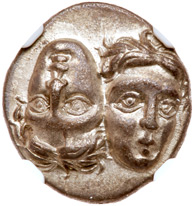 |
Moesia, Istros. Silver Drachm (4.09 g), 4th century BC. Facing male heads, the right inverted. Reverse: IΣTPIH, sea-eagle left, grasping dolphin in talons; below, A. AMNG I 416; SNG BM 237-8; HGC 3, 1803. NGC grade ChAU*; Strike: 5/5, Surface: 4/5. Estimated Value $500 - UP
There is some disagreement about what the two youthful heads may actually represent on the obverse of the drachms struck at Istros. It has been suggested that they may represent the twins Kastor and Polydeukes, who are known collectively as the Dioskouroi ("Boys of Zeus"). The importance of Istros as a trading city on the Black Sea and Danube River make this a plausible suggestion since the Dioskouroi were famous as patrons of seafarers. However, it is a little unusual to see them without their distinctive pilei (most commonly also surmounted by stars). Thus, others have claimed that the two heads are more allegorical in character, with some arguing that they represent the rising and the setting sun or the two mouths of the Danube. Somewhat less controversial is the reverse type depicting a sea eagle with a dolphin, which seems to be related to a similar type employed by the important Black Sea trading center at Sinope on the coast of Paphlagonia. The shared typology suggests a relationship between the two cities, probably in relation to their involvement in the grain export trade.
Purchased privately from CNG, 14 October 2010.
View details and enlarged photos
Realized
$1,560 |
|
Lot 1521 |
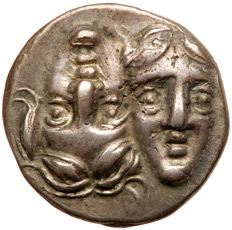 |
Moesia, Istros. Silver Drachm (5.64 g), 4th century BC. Facing male heads, the left inverted. Reverse: IΣTPIH, sea-eagle left, grasping dolphin in talons; between eagle and dolphin, two pellets; below, monogram. Cf. SNG BM 254-5 (no pellets); HGC 3, 1803. Lightly toned. Nearly Extremely Fine. Estimated Value $400 - UP
View details and enlarged photos
Realized
$312 |
|
Lot 1522 |
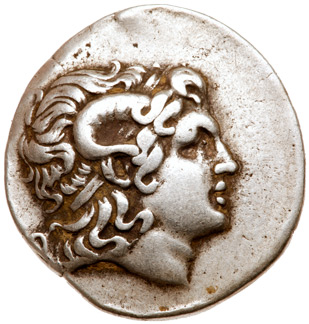 |
Thracian Kingdom. Lysimachos. Silver Tetradrachm (16.58 g), as King, 306-281 BC. Byzantion(?), late 3rd century BC. Diademed head of the deified Alexander right, with horn of Ammon. Reverse: BAΣIΛEΩΣ ΛYΣIMAΧOY, Athena seated left on throne without ornament, holding Nike and resting arm on shield set behind her; leaning against her far side, spear; in inner left field, ZA monogram; on throne, Π. Müller -; SNG Copenhagen -. Fine to Very Fine. Estimated Value $250 - UP
From the KSG David Zeng of Peking Collection.
View details and enlarged photos
Realized
$646 |
|
Lot 1523 |
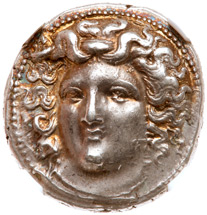 |
Thessaly, Larissa. Silver Drachm (6.07 g), ca. 356-342 BC. Head of the nymph Larissa facing slightly left, hair bound in ampyx. Reverse: ΛAPIΣ-AIΩN, horse standing right, preparing to roll. Lorber phase L-III, 38-60; BCD Thessaly II 317-9. NGC grade AU; Strike: 5/5, Surface: 5/5. Estimated Value $2,000 - UP
The use of the three-quarter facing head on this popular series of Larissean drachms seems to reflect a larger artistic trend in the fourth century BC, set off by the famous depiction of Arethusa by Kimon introduced for Syracusan tetradrachms in ca. 406-400 BC. The representation of Larissa here is very similar to Kimon�s Arethusa, which began a three-quarter facing head fashion for deities at many Greek cities, including Ainos, Rhodes, Kroton, Herakleia in Lucania, and others. At the same time, while the obverse type indicates the connection of the city of Larissa to the wider Greek world, the reverse type is very local and distinctively Thessalian in its emphasis on the horse. Unlike much of mainland Greece, which is broken up by mountains and not especially suitable for raising horses in large numbers, Thessaly was a great plain where horse husbandry and horsemanship were cultivated by the elites of all of the Thessalian cities.
Purchased privately from Bruce Lorich, 29 November 1993.
View details and enlarged photos
Realized
$1,620 |
|
Lot 1524 |
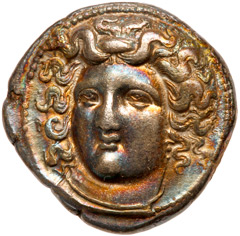 |
Thessaly, Larissa. Silver Drachm (5.81 g), ca. 356-342 BC. Head of the nymph Larissa facing slightly left, hair bound with ampyx. Reverse: ΛAPI-ΣAIΩN, horse standing right, about to roll. Lorber phase L-III; BCD Thessaly II 315-7. Fine style and well centered. Some faint graffiti on the reverse. A stunning obverse, and with a beautiful multi-hued tone. Superb Extremely Fine. Estimated Value $600 - UP
View details and enlarged photos
Realized
$720 |
|
Lot 1525 |
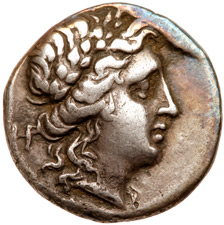 |
Thessaly, Thessalian League. Drachm (4.24 g), Late 2nd-mid 1st centuries BC. Her… and Heg…, magistrates. Laureate head of Apollo right; behind, HP monogram. Reverse: ΘEΣΣA-ΛΩN, Athena Itonia striding right, hurling spear and holding forth shield; in right field, HΓ monogram. BCD Thessaly II 836; BMC 42; McClean 4968. Lightly toned. Very Fine. Estimated Value $200 - UP
View details and enlarged photos
Realized
$228 |
|
Lot 1526 |
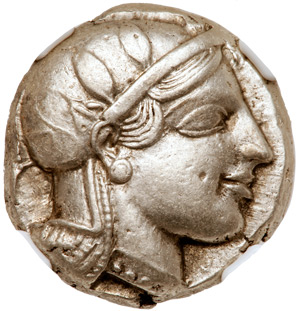 |
Attica, Athens. Silver Tetradrachm (17.18 g), ca. 454-404 BC. Helmeted head of Athena right, frontal eye. Reverse: AΘE, owl standing right, head facing; above to left, olive-spray with berry and crescent; all within incuse square. Kroll 8; Svoronos pl. 14; SNG Copenhagen 31-40. Traces of luster still evident. Well centered and untoned. NGC grade Ch XF; Strike: 5/5, Surface: 3/5. Estimated Value $500 - UP
View details and enlarged photos
Realized
$1,080 |
|
Lot 1527 |
 |
Attica, Athens. Silver Tetradrachm (17.17g), ca. 440-404 BC. Head of Athena right, wearing crested Attic helmet ornamented with laurel leaves and vine. Reverse: AΘE, owl standing right, head facing, olive sprig and crescent moon behind; all within incuse square. HGC 4, 1597; SNG Cop. 31-40; Kroll 8. Boldly struck in high relief perfectly centered with a full crest and nose. Exceptionally lustrous with a light silver-gray tone. NGC graded Choice AU; Strike: 5/5, Surface: 4/5. Estimated Value $500 - UP
View details and enlarged photos
Realized
$1,050 |
|
Lot 1528 |
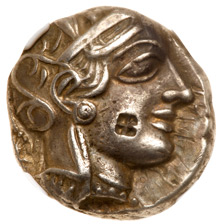 |
Attica. Athens. Silver Tetradrachm (17.12g), ca. 440-404 BC. Helmeted head of Athena right, frontal eye; small incuse square countermark on cheek. Reverse: AΘE, owl standing right, head facing; above to left, olive-spray with berry and crescent; all within incuse square. Two ancient test cuts, one across neck of owl the other across the head. NGC graded Choice XF; Strike: 5/5, Surface: 2/5. Estimated Value $350 - UP
View details and enlarged photos
Realized
$418 |
|
Lot 1529 |
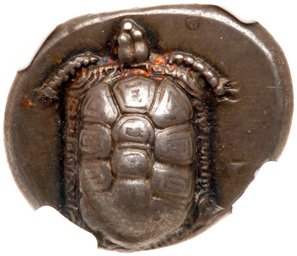 |
Islands off Attica, Aegina. Silver Stater (12.26 g), ca. 370 BC. Land tortoise with segmented shell. Reverse: Large square incuse with thin skew pattern. Milbank pl. II, 14; SNG Delepierre 1545; HGC 6, 438. Marvelous old cabinet tone with hints of iridescence. NGC grade XF*; Strike: 4/5, Surface: 5/5. Estimated Value $5,000 - UP
The island city of Aegina was one of the earliest cities among the European Greeks to strike silver coins and their extensive maritime trade contacts established the Aeginetic weight standard as the primary standard for coinage in the Peloponnesos and among many cities of the Hellespont and Black Sea, in some cases lasting for centuries. The Aeginetan standard and Aeginetan trade influence were spread primarily through the city's coinage, which regularly featured a sea turtle on the obverse and an incuse design (usually a mill-sail or skew pattern) on the reverse. This animal was emblematic of Aegina's trade by sea. Unfortunately for Aegina, in the fifth century BC, the nearby city of Athens grew in both military and economic power through its leadership of the Delian League. Athenian hostility to Aegina grew increasingly and at last, shortly before the outbreak of the Peloponnesian War (431-404 BC), the Athenians seized the island and expelled many of the Aeginetans. It has been suggested that the use of the land tortoise type in this period (and after the restoration of the Aeginetans in 404 BC), rather than the much more common sea turtle of early Aeginetan coinage, may reflect the loss of the city�s old maritime trading empire.
Ex Goldberg (February 2013), 4352; Goldberg (May 2004), 3228; Coin Galleries (March 1956), 1584.
View details and enlarged photos
Realized
$9,000 |
|
Lot 1530 |
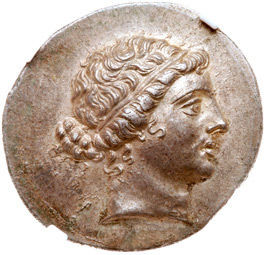 |
Aiolis, Kyme. Silver Tetradrachm (16.75 g), ca. 155-143 BC. Metrophanes, magistrate. Head of the Amazon Kyme right, hair bound with tainia. Reverse: KYMAIΩN, horse standing right, pawing at ground; under raised foreleg, one-handled cup; in exergue, magistrate's name: MHTPOΦANHΣ; all within laurel wreath. SNG Copenhagen 104; Warren 1060. NGC grade ChAU; Strike: 5/5, Surface: 4/5. Estimated Value $1,000 - UP
Broad-flan reduced Attic-weight tetradrachms with reverse types featuring a wreath border became popular in western Asia Minor under the influence of the Athenian New Style tetradrachm coinage that was probably introduced around 165 BC. Hoard provenances have led to the suggestion that many of these so-called "wreathed" coinages - especially those of Kyme - may have been employed by the Attalid dynasty to effect a change of regime in Seleukid Syria. They seem to have financed the struggle of the Seleukid pretender Alexander I (originally a citizen of Smyrna) against the hated Demetrios I. This coin depicts Kyme, the Amazon queen who is said to have founded the city. There appears to have been a local tradition of city foundations by Amazons in Aeolis and Ionia, for Smyrna and Myrina both also claimed to be named after Amazonian founders. However, Kyme was the only city to represent its founder on its wreathed coinage.
Purchased privately from George Beach, 6 March 1993.
View details and enlarged photos
Realized
$2,220 |
|
Lot 1531 |
 |
Aeolia, Myrina. Silver Tetradrachm (16.84 gm). ca. 155-145 BC. Laureate head of Apollo right. Reverse: MYPINAIΩN, monogram to left. Apollo Grynios standing right, holding branch and patera, omphalos and amphora at feet; all within laurel wreath. SNG von Aulock -. Boldly struck in high relief on a nice wide flan and perfectly centered. Elegant style and untoned. Extremely Fine. Estimated Value $800 - UP
Ex Ora Eads Collection; Ex CNG Sale 41, March 19, 1997, lot 535.
View details and enlarged photos
Realized
$2,100 |
|
Lot 1532 |
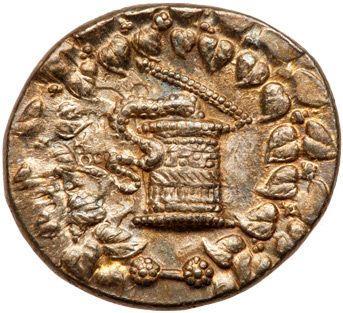 |
Ionia, Ephesos. Silver Cistophoric Tetradrachm (12.70 g), ca. 180-67 BC. RY 1 of Attalus III of Pergamum (139/8 BC). Serpent emerging from within cista mystica with open lid; all within ivy wreath. Reverse: Bow case between two entwined serpents; above, A and bee; in left field, EΦE; in right field, cornucopiae. Kleiner-Noe 35; DCA 318. With luster still present and light golden toning. Superb Extremely Fine. Estimated Value $300 - UP
View details and enlarged photos
Realized
$432 |
|
Lot 1533 |
 |
Lydian Kingdom. Kroisos. Gold Stater (10.72 g), ca. 564/53-550/39 BC. Heavy standard, regular issue. Sardes. Confronted foreparts of lion and bull. Reverse: Two incuse squares. Berk 2; SNG Ashmolean 759; SNG von Aulock 2873-4. Perfectly centered with plenty of luster still present. NGC grade Ch VF; Strike: 5/5, Surface: 5/5. Estimated Value $7,500 - UP
King Kroisos of Lydia is credited for not only his immense wealth, but for creating the first bimetallic coinage of gold and silver. The heavy weight gold stater and the heavy weight silver stater, This was followed by the light weight versions, 4 in gold and 22 in silver all carry the same basic features, the Lion and the Bull representing strength and fertility.
The earliest gold coins, the staters of Kroisid type come in two weight standards, an earlier heavy standard with both gold and silver staters weighing around 10.7 grams, and a later light or reduced standard with the weight of gold staters around 8.17 grams. This particularly fine example belongs to the earlier, heavy series, with a weight of 10.72 grams. The heavy staters are the earliest struck by the Lydian kings and are dated to the period when Kroisos was kind. They are also quite rare as they were struck for only a relatively short time.
View details and enlarged photos
Realized
$23,400 |
|
Lot 1534 |
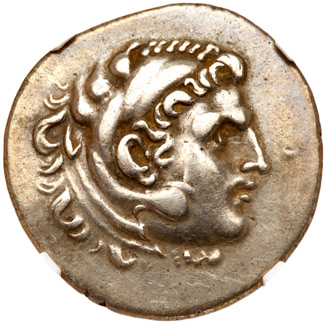 |
Caria, Alabanda. Silver Tetradrachm (16.52 g), ca. 188-156 BC. Types of Alexander III 'The Great' CY 5 (165/4 BC). Head of Herakles right, wearing lion's skin headdress. Reverse: AΛEΞANΔPOY, Zeus seated left, holding eagle and scpter; in left field, Pegasos left; below throne, E. Price 2464; DCA 311. NGC grade Ch VF; Strike: 5/5, Surface: 3/5. Estimated Value $300 - UP
View details and enlarged photos
Realized
$540 |
|
Lot 1535 |
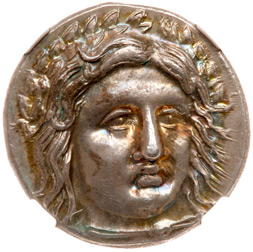 |
Carian Satraps. Pixodaros. Silver Didrachm (7.03 g), ca. 341/0-336/5 BC. Halikarnassos. Laureate head of Apollo facing slightly right, drapery tied at neck. Reverse: ΠIΞOΔAPOY, Zeus Labraundos standing right, holding labrys. Konuk 30; SNG Keckman 280; SNG Kayhan 891-2. Beautiful toning and superb strike, an incredible piece! NGC grade ChAU; Strike: 5/5, Surface: 4/5. Fine style. Estimated Value $4,000 - UP
Pixodaros was the youngest of the children of the powerful Carian dynast Hekatomnos. In 340 BC, after deposing his sister Ada, he attempted to gain support for his rule by forming a marriage alliance with Philip II of Macedon. He offered the hand of his daughter to Philip, but the Macedonian king declined and instead suggested that Pixodaros� daughter should marry his elder illegitimate son, Arrhidaeus. However, when Philip�s younger son Alexander III (the Great) discovered the proposal, he feared that Arrhidaeus might become recognized as the rightful heir to the Macedonian kingship. He therefore entered into his own correspondence with Pixodaros and offered himself as a superior match for his daughter. The negotiations fell apart when Philip II realized what Alexander had done. Realizing that he could not form the desired marriage alliance with Philip II, Pixodaros subsequently ensured the security of his rule by marrying his daughter to Orontobates, an influential Persian nobleman. Pixodaros was officially recognized as the Persian satrap of Caria and Lycia, as indicated by a trilingual inscription in Greek, Aramaic, and Lycian dated to 337 BC, but he seems to have died the following year, leaving Orontobates to succeed him. The present didrachm was struck from a die pair that is well known from the famous Pixodaros hoard (CH 9.421), but far outshines any of the pieces in that accumulation in terms of its incredibly sharp strike and beautiful toning.
Purchased privately from Edward J. Waddell, 3 May 2013.
View details and enlarged photos
Realized
$5,760 |
|
Lot 1536 |
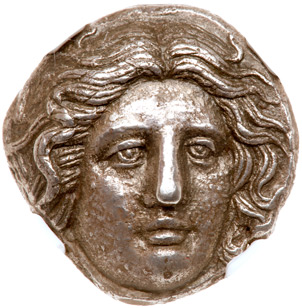 |
Islands off Caria, Rhodes. Silver Tetradrachm (14.98 g), ca. 404-385 BC. Head of Helios facing slightly right. Reverse: POΔION, Rose in profile, bud to left; to left, Φ; to right, kylix; all within incuse square. Ashton 44; Hecatomnus 110-3; Bérend -; SNG Keckman -; HGC 6, 1418. NGC grade ChAU*; Strike: 5/5, Surface: 4/5. Fine style. Estimated Value $15,000 - UP
Whereas in later periods Rhodes primarily struck smaller denominations like drachms and didrachms, the present coin is a wonderful early tetradrachm struck to the heavy Chian standard, rather than the reduced Rhodian standard introduced in the later fourth century BC. It was struck, probably in support of naval operations undertaken during Corinthian War (395-387 BC), which pitted a coalition of Greek cities against Sparta and frequently involved Persian satraps playing each side against the other. Shortly before the conflict, the Rhodians had been instrumental in stirring up the cities of mainland Greece against Spartan hegemony by distributing money sent by Pharnabazos, the Persian satrap of Hellespontine Phrygia. In 396 BC, Rhodes served as a naval base for Pharnabazos and the Athenian general Conon against the Spartans and faced direct Spartan attack in 392 BC. However, the Spartans were forced to abandon the Rhodian campaign in 389 BC. The conflict was finally brought to an end under the terms of the King's Peace (387 BC), which forced Athens and Sparta to recognize Rhodes as an autonomous city under Persian sovereignty.
The present tetradrachm firmly establishes the types that would become emblematic of Rhodes for the remainder of its history. The obverse type depicts the Greek sun-god Helios, the patron deity of Rhodes. This god was later depicted in monumental form at the entrance to the harbor of Rhodes when the famous Colossus of Rhodes was constructed in 292-280 BC. The use of the three-quarter facing head here shows that in the early fourth century, Rhodes was attuned to artistic trends in the wider Greek world. At the same time that Rhodian Helios was being depicted three-quarter facing, so too was Arethusa on coins of Syracuse and Larissa on coins of her eponymous Thessalian city. The reverse type depicts a rose (rhodos in Greek) as a punning badge of the city's name.
*This coin contains the COIN WORLD PLUS sticker.
Purchased privately from Edward J. Waddell, 30 April 2012; G. Hirsch 275 (22 September 2011), 3902; Sternberg XIX 19 November 1987), 202.
View details and enlarged photos
Realized
$21,600 |
|
Lot 1537 |
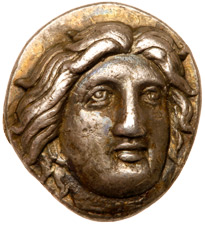 |
Islands off Caria, Rhodes. Didrachm (6.88 g), ca. 316-304 BC. Head of Helios facing slightly. Reverse: POΔIΩN, Rose with bud to right; grape cluster on vine tendril left, E to right. Ashton, Colossus Series 1b; SNG Keckman 445. Lovely old cabinet tone. Choice Very Fine. Estimated Value $400 - UP
View details and enlarged photos
Realized
$600 |
|
Lot 1538 |
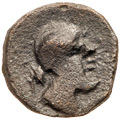 |
Kings of Armenia. Uncertain King, ca. 200 BC. AE Chalkous (13 mm, 1.03 g). Head of an uncertain king to left, wearing bashlyk tied with a diadem; around, uncertain Aramaic legend. Reverse: Draped bust of an uncertain queen facing right. Kovacs -; Leu 4 (2019) #361 same reverse die. Of the highest rarity, only the second or third known with this being the finest example. Excellent dark brown patina. Extremely Fine. Estimated Value $1,000 - UP
For a discussion of this interesting issue, see Leu 4, 25 May, 2019 #361 (realized 4200 CHF).
From the Tareq Hani Collection.
View details and enlarged photos
Realized
$780 |
|
Lot 1539 |
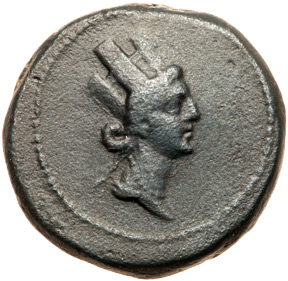 |
Kings of Armenia. Sophene. Artagigarta. AE Oktachalkon (24 mm, 14.22 g). Civic Year 11 (54/3 BC.) Draped and turreted bust of the city-goddess facing right. Reverse: Wreath with ties inward; to left, AI; to right, monogram of ΠO. Kovacs 211 correction (reverse image upside down). In exceptional condition for an Armenian civic issue, boldly struck on a nice broad flan with lovely dark greenish-brown patina. About Extremely Fine. Estimated Value $1,000 - UP
A similar example sold at Leu Winterthur Auction 7, 24/10/20 (realized 2400 CHF).
From the Tareq Hani Collection.
View details and enlarged photos
Realized
$1,920 |
|
Lot 1540 |
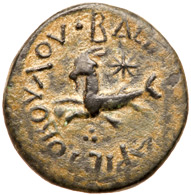 |
Kings of Armenia. Aristobulus, AD 54-92. AE Chalkous (18 mm., 2.51 g). Struck at Nicopolis ad Lycum, year IΓ Year 13 = AD 66/7. BACIΛE wC APICTOBOYΛOY Capricorn to left with globe between his forelegs, with star above and three pellets below. Reverse: Hand to left, holding scales enclosing ETO /VC. /IΓ between balance pans. RPC II Online 3840A.1 (this coin). Pleasing brown patina with lighter highlights. Choice Very Fine. Estimated Value $750 - UP
CoinArchives lists a similar specimen (spots of corrosion removed) sold at Nomos 8 May 2021, #437 realized $2200 US.
From the Tareq Hani Collection.
View details and enlarged photos
Realized
$1,260 |
|
Lot 1541 |
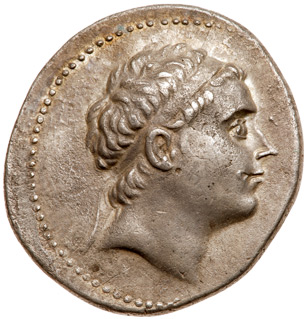 |
Seleukid Kingdom. Antiochos III. Silver Tetradrachm (16.29 g), 223-187 BC. Antioch on the Orontes, series 2, ca. 211/0-209/8 BC. Diademed head of Antiochos III right. Reverse: BAΣIΛEΩΣ ANTIOΧOY, Apollo seated left on omphalos, testing arrow and resting hand on grounded bow; in outer left and right fields, monograms. Cf. SC 1043.1 (no monogram in left field); HGC 9, 447u. Lighty toned and of fine style. Choice Very Fine. Estimated Value $400 - UP
From the KSG David Zeng of Peking Collection.
View details and enlarged photos
Realized
$480 |
|
Lot 1542 |
 |
Seleukid Kingdom. Antiochos III. Silver Tetradrachm (16.38 g), 223-187 BC. Uncertain mint. Diademed head of Antiochos III right. Reverse: BAΣIΛEΩΣ ANTIOΧOY, Apollo seated left on omphalos, testing arrow and resting hand on grounded bow; in outer left and right fields, unclear monograms. Cf. SC 1042 (Amtioch); cf. HGC 9, 447u (same). Toned. About Very Fine. Estimated Value $250 - UP
From the KSG David Zeng of Peking Collection.
View details and enlarged photos
Realized
$276 |
|
Lot 1543 |
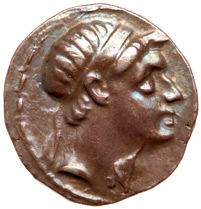 |
Seleukid Kingdom. Demetrios I Soter. Silver Drachm (3.81 g), 162-150 BC. Ekbatana. Diademed head of Demetrios I right. Reverse: [B]AΣIΛEΩΣ ΔHMHTPIOY ΣΩTHPOΣ, Apollo Delphios, testing arrow and resting hand on grounded bow, seated left on omphalos; to outer left, palm branch. SC 1735.2; HGC 9, 803a. Magnificent deep iridescent toning. Nearly Mint State. Estimated Value $300 - UP
View details and enlarged photos
Realized
$240 |
|
Lot 1544 |
 |
Seleukid Kingdom. Antiochos VII Euergetes. Silver Tetradrachm (13.65 g), 138-129 BC. Tyre, SE 180 (133/2 BC). Diademed and draped bust of Antiochos VII right. Reverse: BAΣIΛEΩΣ ANTIOXOY, eagle standing left on prow left, palm branch over far wing; in left field, A/PE above club surmounted by monogram of Tyre; in right field, monogram above date (ΠP); between legs, monogram. SC 2109.8a; HGC 9, 1074. Toned. Choice Very Fine. Estimated Value $250 - UP
View details and enlarged photos
Realized
$312 |
|
Lot 1545 |
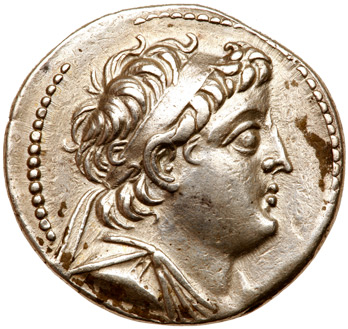 |
Seleukid Kingdom. Demetrios II Nikator. Silver Tetradrachm (14.01 g), second reign, 129-125 BC. Tyre, SE 186 (128/7 BC). Diademed and draped bust of Demetrios II right. Reverse: BAΣIΛEΩΣ ΔHMHTPIOY, eagle standing left on prow left, palm branch over far wing; in left field, A/PE above club surmounted by monogram of Tyre; in right field, monogram above date (ςΠP); between legs, M. SC 2195.4c; HGC 9, 1122. Some areas of verdigris on the obverse. Extremely Fine. Estimated Value $300 - UP
View details and enlarged photos
Realized
$456 |
|
Lot 1546 |
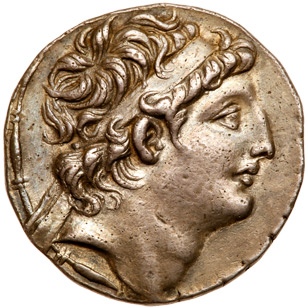 |
Seleukid Kingdom. Antiochos VIII Epiphanes. Silver Tetradrachm (16.58 g), sole reign, 121/0-97/6 BC. Ake-Ptolemaïs, ca. 121/0-113 BC. Diademed head of Antiochos VIII right. Reverse: BAΣIΛEΩΣ ANTIOΧOY EΠI-ΦANOYΣ, Zeus Ouranios, nude, standing facing, head left, holding star and scepter; to outer left, M; all within laurel wreath. SC 2335.2; HGC 9, 1196g. Beautiful old cabinet tone. Extremely Fine. Estimated Value $300 - UP
View details and enlarged photos
Realized
$840 |
|
|
|